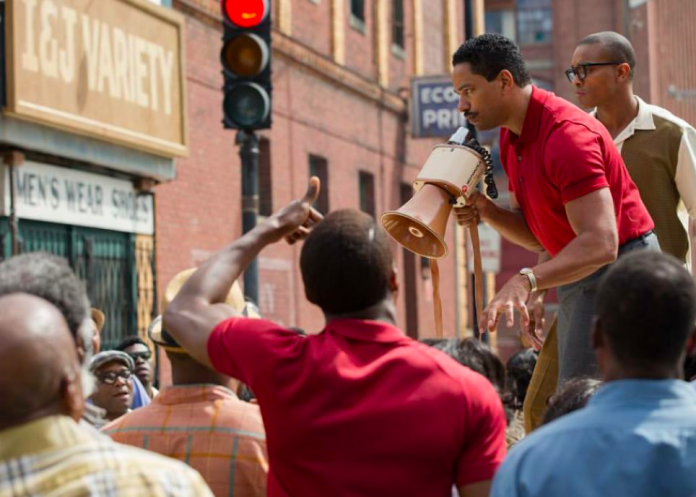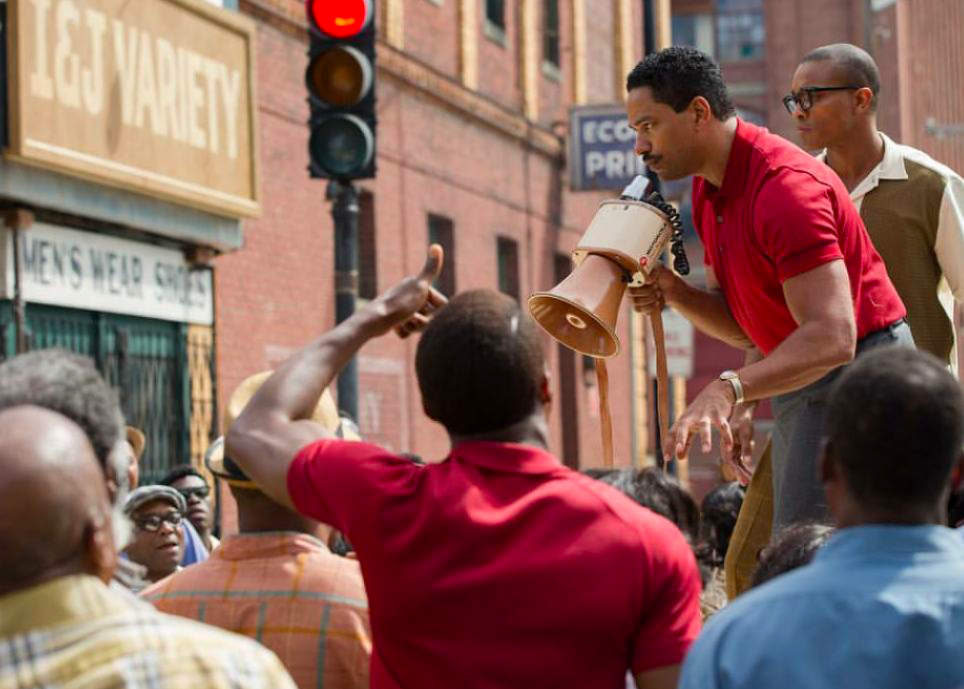
Detroit is the most gut-wrenching movie I have ever seen.
Fifty years ago, in 1967, San Franciscans here in our City by the Bay were being beseeched to wear flowers in their hair and bask in the glow of the so-called Summer of Love. That same summer, the Detroit ghetto exploded in rebellion, one of the biggest of the ghetto uprisings during the “long, hot summers” of 1964-69. In response, the forces of repression in Detroit unleashed a murderous wave of gunfire and fury that left dozens dead and thousands arrested.
Settling into my seat to watch Detroit, directed by Kathryn Bigelow, I endured several hyper-violent previews starring Bruce Willis, Tom Cruise and such. In these trailers the gunplay and violence was scripted, formulaic, and unreal. Then Detroit began, and the real violence took over.

The movie begins with Detroit cops busting up an unlicensed after-hours club scene. A Black Uncle Tom cop is in charge, working in tandem with a snitch that the cop pretends to rough up. “You got a lot of open warrants here,” says the snitch, “and don’t forget to search the women.” Meanwhile, the white cops are trying to break into the back door of the club, but can’t get in that way. They realize that they are going to have to take the patrons of the club out the front door in a very public situation, and that they might have trouble. They do. A crowd gathers, angry at the cops. The cops load their charges into police vans, but not fast enough to avoid the wrath of the street. Under a barrage of threats and thrown objects, Detroit’s finest hightails it out of the area, leaving the crowd with a feeling of victory. Now the crowd owns the street, and the looting, the burning, and the rebellion begin.
You have never seen the urban ghetto rebellions of the 1960s portrayed on the screen like this. You are there, and it is startlingly and viscerally real. This is the “sixties” that has been buried by the media and the mainstream historians, come to life 50 years later. This is not the beats or the hippies or the Yippies or the New Left or the give peace a chancers. This is the pure, unadulterated cry of the most exploited of the exploited, taking its revenge on the “Great Society” that has left them with very little to lose.
Nor are these scenes of the uprising of a kind with the surreal, ironic vision of Apocalypse Now, another movie that portrayed another brutal scenario going on at the same time in a land far, far away – but which was as intrinsic to these events as blood is to the body. You see a little girl taken out by the National Guard because they mistake her for a sniper. You see a racist cop shoot a looter in the back. You see a young John Conyers, today a Congressman, lecture the crowd about calming down, only to be met by cries of “We want Stokely Carmichael!” There is no release from the overwhelming sense that the time has come, today, and that there is no escape.
The story eventually focuses on the notorious events at the Algiers Motel, where the Detroit pigs (believe me, they earn that epithet) invade, looking for a sniper who never existed, and beat and brutalize everyone in sight, murdering three. The scenes at the Algiers Motel go on and on, unrelenting. The Michigan State Police and the National Guard hover around, but do nothing to put an end to the brutality. You keep waiting for one of the people in authority to come to their senses and put an end to this madness. That is indeed what would happen if this were a typical Hollywood tale, but it never happens. No superhero comes to the rescue.
You may have all sorts of qualms and reservations about the violence of the Detroit rebellion, but by the time the Algiers Motel incident ends you would have to be naive beyond belief not to understand and feel what was fueling the rage in the street.
Help us save local journalism!
Every tax-deductible donation helps us grow to cover the issues that mean the most to our community. Become a 48 Hills Hero and support the only daily progressive news source in the Bay Area.
The movie then descends into a trial of three Detroit cops for their inhuman actions. Forgive the spoiler, but – surprise, surprise – the all-white jury acquits them. If you had any hopes otherwise, you haven’t been reading the news for the last 50 years. And of course there is a crowd of blue-uniformed comrades in the courtroom to celebrate the acquittal. There is no happy ending to this story.
The received wisdom in liberal and progressive circles is that the Civil Rights Movement of the 1950s and 1960s was all about people sitting in at lunch counters, riding Freedom Busses, marching across the Selma bridge, all the while turning the other cheek to police dogs, fire hoses, KKK violence, and other unspeakable horrors. The culmination of all this was supposedly the Civil Rights Act of 1964 and the Voting Rights Act of 1965.
This great movement was righteous and essential, the product of the work of thousands and thousands of brave, freedom-loving people.
But if the culmination of this movement was laws passed by Congress in 1964 and 1965, then why the Watts rebellion in 1965, just days after the Voting Rights Act was signed into law? Why Detroit in 1967? Why scores of such uprisings in the “long, hot summers” of 1964, 1965, 1966, 1967, 1968, and 1969?
The fact is that these urban rebellions were an intrinsic part of the movement for racial justice in this country. They put white America on notice that equality is not just a law or a noble ideal, but something that needs to be made real for every man, woman and child, in the North and in the South, in every tenement and in every slum, on the job and on the street, in every corner of this land.
Detroit is a story of violence. But what lies behind this violence is the real story.
The violence of the Detroit rebellion portrayed so well by the movie is but the symptom of the underlying disease, just as the ravages of a fever is only the symptom of infection. That disease is the system of injustice that Black people suffer through every day.
The violence of the police, of the National Guard and of all the forces of repression, also portrayed so graphically by Detroit, is but another symptom of the underlying disease of this system of injustice. Injustice inevitably and constantly fosters rebellion – and consequently the repression necessary to put those rebellions down.
That is precisely why the mass incarceration of Black people, people of color, and poor people in general became necessary for our rulers, and why that regime of mass incarceration continues to this day.
If history has taught us anything, it is that this violence and brutality will not disappear until the disease of racism and injustice disappear forever.
Let’s remember: 1967 was both the year of the Detroit rebellion, and of San Francisco’s vaunted Summer of Love. The contradictions remain, no matter how hard we try to bury them, although always in new forms and new circumstances. Detroit, the movie, helps us understand our history, which is another way of saying it helps us understand the present. The struggle continues.
Marc Norton’s website is www.MarcNorton.us.


And while the Haight was enjoying its Summer of Love, SF's largest and liveliest Black neighborhood, The Fillmore, was being razed to the ground a couple of miles away.
Excellent review of a powerful film.